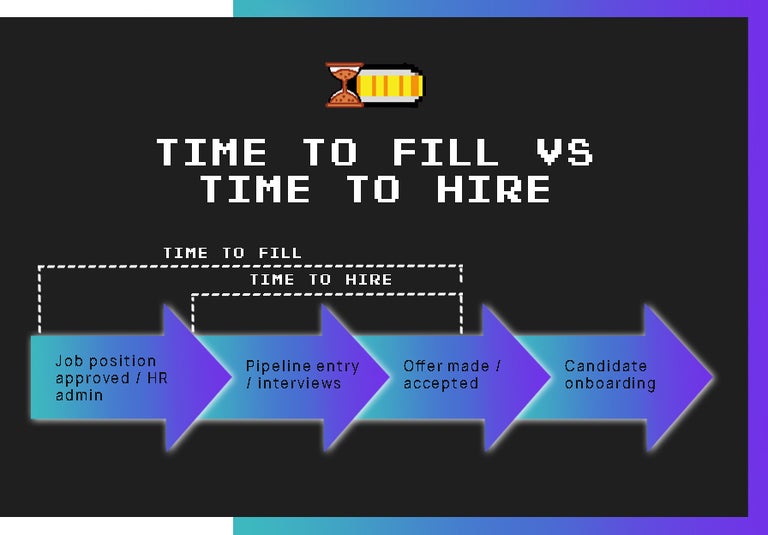Contents
- Time to End the Hiring Madness
- Time to Fill vs Time to Hire: What’s the Difference?
- Finding The Hidden Warp Zone
- Solving Bad Hiring Practices
- A Warp to The Finish Line: Grab Your Power Up
Time to fill isn’t just another recruitment metric – it’s an opportunity to optimize your remote hiring process. By drastically cutting it, you redefine the candidate’s journey with your company.
Today I’m talking about transforming your hiring operations by turning your time-to-fill metric into a warp zone. And what that will do for your remote recruitment process.
Time to End the Hiring Madness
It’s official – recruiters across industries are taking LONGER to hire people.
That’s bleak for everyone involved. From the applicants shooting off hundreds of resumes with no interviews to show for it, to the overwhelmed recruiters who have to review them.
Resume screening is just one in a long line of inefficient practices plaguing the recruitment space right now.
But it’s certainly not the only one.
Depending on the industry, it takes about 42 days to go from zero to candidate hire in 2023. According to the Time-to-Hire Factbook, hiring in APAC, EMEA, and LATAM will be more challenging and unpredictable this year.
And this is based on hiring data from eight industries across 25 countries.
At one point tech hires averaged at 70 days, though they’re floating around 41 now. But the data is clear: time-to-hire is trending up, which means time-to-fill is more critical than ever.
Time to Fill vs Time to Hire: What’s the Difference?
There are some key differences between time to hire vs time to fill. The two are often used interchangeably, but they’re quite different.
Time to hire should be the main focus for your recruiters. While time to fill is a metric that needs to be cut down to size – for efficiency.
Defining Time to Hire
The clock starts on time to hire the moment a candidate becomes an active part of your recruitment pipeline. Time to hire measures how long it takes a viable job candidate to start along your hiring pipeline - until they’re hired.
- It begins after HR admin (meetings, job description creation, post write-up…)
- When the first viable candidate enters the pipeline

Defining Time to Fill
Time to fill on the other hand, encompasses the entire process - admin and all. Usually this begins when a job opening has become available, and the HR team is given approval to fill it.
So, it’s time to fill that measures the number of days it takes to find and then hire a suitable candidate. And – within this metric lies the secret to performance recruiting.

Finding The Hidden Warp Zone
Did you ever play Super Mario Bros as a kid?
It was always exciting discovering those hidden warp zones that would take you to a later stage in the game.
Why not avoid those whirling fire spirals, flying turtles and manic mushrooms level-after-level?
I almost felt bad watching friends die repeatedly and then give up in the early stages of the game.
The warp zones were a great cheat. I had more shots at Bowser and saving Princess Peach. I won – not because I didn’t die as often as other players – but because when I did it was on the highest levels.
The modern hiring process is a lot like Super Mario Brothers.
There are a lot of random stages filled with obstacles that can end your game. Loads of applicants never make it to interview, and the ones who do are often ‘coincidental winners.’
When playing the game takes ages, there’s not much energy left on either side for the final stage.
Recruiters are exhausted and disillusioned from dud interviews, and candidates are irritated at the sheer number of interviews it takes to be taken seriously as a viable player.
But… what if your hiring team could put a warp zone in place?
A way for the most talented, most interested and most skilled players to simply…leap forward a few stages. A warp zone could eliminate endless searching, screening, and resume rejection.
You could put your team’s energy into the final interview. Where it belongs.
And that means turning your most problematic metric into your most efficient one.

Solving Bad Hiring Practices
There are two main problems with today’s hiring processes. Solve these and you’ll dramatically accelerate your time to fill metric.
Because there are warp zones for these practices, if you know where to look!
1) Say No to Shotgun Hiring
Have you heard of shotgun hiring?
It’s startlingly common among HR teams. The time comes to start searching for applicants, so the job post goes live on LinkedIn or Indeed. And anyone can apply!
Without a second thought, your team has just created a ton of admin and wasted time – trashing your recruitment metrics.
- No automatic filtering (anyone can apply, and they do)
- 250 resumes on average flood in
- On average each resume takes 6 seconds to review
If a hiring manager has 40 open jobs at any time, and it takes them 25 minutes to review 250 resumes for one job opening - the fact is: they’re not making good decisions. They’re making fast decisions. Easy decisions. Flawed decisions.
The result:
- Bad candidate matches
- Low diversity
- Onboarding issues
- High attrition
Because of this simple process error, instead of using your HR team to assess candidate fit – you’re using them as a human search engine. Full of biases, opinions and sure-fire ways to miss those needles hiding in the haystack you just created.
It’s a blatant misuse of resources.
Doesn’t it make more sense to remove the haystack altogether?
Put the shotgun down and pick up a rifle. Move from anyone, anywhere – to tapping into a targeted talent pool of global candidates that have already proven their skills and value.
- Embrace skills-based hiring
- Draw from a pre-vetted global talent pool
When you make this easy switch – you create a warp zone for your HR team. Skip the duds, the useless resume screening, the endless interviews, the low-quality shortlists.
Just appear at the next stage like Mario does.
It optimizes your time to fill metric and can 4X your hiring speed. That means better quality candidates who can actually do the job.
All your team has to do is focus on the interview phase to pick someone for culture fit.
2) Say No to Broken Hiring Systems
Recruiters often lean into automated solutions to enhance their recruiting pipeline metrics. Their instinct is right, but the process is wrong. And that’s because these solutions aren’t perfect.
Applicant tracking systems for example:
· Can be tricked (a good resume doesn’t = a good hire)
· Unnecessary / unfair elimination of qualified candidates
· Built to recognize keywords not talent
· Can be brutal with proxies (resume gaps or not the right degree)
While AI-driven applicant tracking systems are smart, they’re also limited. In a revealing 2020 report from Harvard Business Review, inflexible ATS were cited as the reason so much talent is hidden from employers and recruiters.
With most ATS, failure to meet specific criteria means candidate elimination. In the report, 88% of employers agreed that qualified, highly skilled candidates were vetted out of the process because their resumes didn’t match the job description.

AI and automation are two essential technologies needed for process improvement – but used like this they amplify and reinforce rigidity.
Instead of wasting time optimizing the way we sift through haystacks, the focus should be on using AI to surface matches from a bag of needles. In time to fill, the problem is solved when the candidate pool is pre-vetted and tested.
- 91.4% of companies who use skills-based testing see a reduction in time to hire
- 91.1% see an increase in diversity in their talent pipeline
- 91.2% of companies see an increase in retention rates
Clearly, tapping into a global talent pool of skilled talent is the warp zone your HR team’s been looking for. Once you’ve hired that way, your team never goes back.
A Warp to The Finish Line: Grab Your Power Up
The hiring process often mirrors the leaps and levels of a video game. But like in Super Mario, the quickest way to win isn’t to fight everyone at every stage.
It’s to find and use those secret shortcuts that allow true talent to shine.
- Streamline time to fill: When you remove the haystack, finding needles is easier. Cut your admin time and you don’t just hire faster, you hire smarter.
- Drop the shotgun: Forget about mass recruitment. Embrace skills-based hiring and zoom past the obstacles. Choose from a pool of pre-vetted talent and suddenly you’re on a warp path headed straight for top-notch interviews from a shortlist of winners.
- Revamp your automation: AI can be like Mario’s power up, but only if you use it right. Relying on ATS AI feels like falling into a pit. Harness AI to spotlight talent, not bury it.
- Use warp zones: A pool of pre-vetted global talent is your warp zone. Build it into your hiring pipelines and skip all of those time-hungry stages. Go straight to the real action.
Use your newfound warp zone to optimize your time to fill recruiting metrics, and revolutionize your hiring process.
With a global talent pool of proven candidates, AI can simply reach in and find who you need in an instant. It’s not the future, it’s now.
Cut time to fill by 80%: Hire with Crossover Prime
We can help you hire top 1% global talent.









